
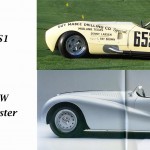
Here You Can See The Similarity Between The BMW and Victress Automobiles. This Prewar Design Was Created in 1939 By BMW And Executed by Carrozzeria Touring of Italy.
Note:
This is the second installment of a 3 part series of articles on “Designs That Influenced The Styling Of The Victress S1 And Glasspar G2.” Here are links to the other parts of the story:
——————————–
Hi Gang…
A bit of a “change” today for you.
Rick D’Louhy and I have added detail and separated out information from our previous story on “Designs That Influenced the Styling of the Victress S1 and Glasspar G2.” The initial story will now be separated into 3 distinct stories on our website. Today’s story is “Part 2” of this series.
The previous story is now tailored to the design influences of the Jaguar XK120 on both the Glasspar G2 and the Victress S1. We’ve updated pictures in “Part 1,” and added comparison images too. You may want to check this story out again (see link below). Today’s story moves to the design of the 1939/1940 BMW 328 Mille Miglia and its influence on both of these cars.
The final story, “Part 3” of this article, will focus on the 1939 BMW 328 Mille Miglia “Buegelfalte” Roadster – the first of the series of “BMW 328 Mille Miglia” Roadsters, and its even greater similarity to the Victress S1. This article will appear later this week.
The changes and expansion of the original story (adding detail and separating into a succession of 3 articles) was necessary to both limit the size of each of the articles, as well as add information that was critical. We believe the end result will provide the necessary detail to strongly link the inspirations of the designs of the Victress S1, Glasspar G2, to both the Jaguar XK120 and the BMW 328 Mille Miglia Roadster.
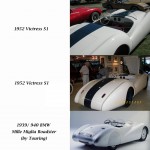
These Comparison Images Show The Rear Of Both The BMW And Victress Automobiles. Keep In Mind That The Victress S1 is On A 100″ Wheelbase While The BMW’s Is 94.5″.
Here’s the link to the previous story – now focused exclusively on the design influences of the Jaguar XK120 on the Glasspar G2 and the Victress S1:
Designs That Influenced The Styling Of The Victress S1 And Glasspar G2: Part 1 – The Jaguar XK120
And now for today’s story….
1939/1940 BMW 328 Mille Miglia by Carrozzeria Touring:
Although this car was new to me, it’s not new to automobile enthusiasts across the world. Again (as I did in part 1 of this story) I turned to Robert Cumberford and his book, “Auto Legends: Classics of Style and Design” for a better understanding of the design of this car. Here are some of his key points:
“One of about half a dozen BMW 328 chassis clothed with aerodynamic bodywork for high-speed races such as Le Mans and the Mille Miglia, this car is particularly significant for the clear influence it had on the Jaguar XK120, which appeared ten years later. One sees every line of the British car, but in a slightly puffy, far less lithe form.
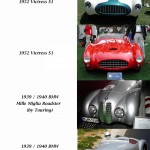
Only The Front Of The Victress S1 Is Significantly Different In Design From The BMW 328 Mille Miglia Roadster.
BMW built a few aerodynamic cars to its own designs, but they had none of the elegance of bodies by “Carrozzeria Touring,” so the Italian house was engaged to create a Le Mans coupe inspired by the racing Alfa Romeo berlinettas it had built earlier. “Weight is the enemy – wind resistance is the obstacle”, and the company lived by its credo.
There is a certain conservatism in the lines of the roadster – and in the Jaguar inspired by it – in that the front and rear wings (another term for fenders) are kept clearly separate. Certain other aerodynamic cars of the period, and specifically the winning BMW Touring coupe, had pure pontoon forms, with no separate indication of front and rear wheelhouses.
The bodywork was wholly Italian and the best application of the design was British.”
Robert was kind enough to call me earlier this week and review some of the key points of the design that made the 1939/1940 BMW 328 Mille Miglia unique for its era. During this conversation, he re-emphasized what he had said in his book. Namely, that the front fender line dramatically drops toward the rear of the car distinctly separating front and rear fenders. Other designers imitated this style, but none used the significant descent of this line toward the rear of the car as BMW did in the design of their 328 Mille Miglia Roadster.
Simiarities to the Victress S1 and Glasspar G2:
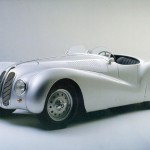
The BMW 328 Mille Miglia Is A Strikingly Beautiful Car. It’s Hard To Believe This Design Debuted In 1939!
Clearly both the Victress S1 and the Glasspar G2 emulated the design lines of the Jaguar XK120. And the Jaguar’s heritage, as Robert Cumberford points out, lies in the design of the BMW 328 Mille Miglia. But the Victress S1 goes one step further.
If you inspect the design of the rear of the BMW, you’ll see a very similar profile to the Victress S1. This same comparison is not true for the Glasspar G2. And when you “visually” remove the fender skirts from the BMW, the rear of both the BMW and Victress S1 became strikingly similar.
Erich Schultz and I think that when Doc Boyce-Smith and Hugh Jorgensen were going to design a car that would “out Jag the Jaguar”, they were also inspired by the design that led to the creation of the Jaguar XK120 – the BMW 328 Mille Miglia Roadster.
Both Doc and Hugh were car enthusiasts from the 1940’s, and Hugh Jorgensen – being a student at the Art Center College of Design in Pasadena, California at that time – would have had ready access to classic designs such as the 1939/1940 BMW 328 Mille Miglia Roadster.
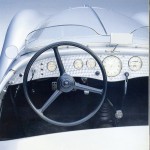
Shown Here Is The Dashboard of the BMW 328 Mille Miglia Roadster. I Think I’ll Be Using This As The “Prototype” Dashboard For Any Future Victress S1 Projects. You Also Might Notice That It’s Nearly Identical To The Factory Dashboard Of Tritt’s Glasspar G2.
Technical Specifications of the BMW:
For those of you interested, let’s review a bit more about the technical specifications of this BMW:
- Engine: 130 horsepower, 1971 cc inline (2.0 litre) 6-cylinder engine
- Transmission: 4 speed manual
- Front Suspension: Independent front suspension with transverse leaf spring
- Rear Suspension/Axle: Live axle rear suspension with semi-elliptical leaf springs
- Brakes: Four-wheel hydraulic drum brakes
- Weight: 1543 lbs
- Top Speed: 93.225 mph (stock)
- Wheelbase: 94.5 inches
- Front Track: 45.4 inches
- Rear Track: 48 inches
So the BMW is about the same size as the postwar MG TC and MG TD, and matches the same wheelbase (94 inch wheelbase) as the following vintage fiberglass sports cars:
- Bill Burke’s Allied (a 1946 Cisitalia 202 coupe splash) introduced in late 1952
- the Vale by Vale Wright introduced in 1952
- the Victress S5 introduced in 1955
- the Sorrell SR200 introduced in the late 1950’s by Bob Sorrell
- the Clearfield Plastics Sabre (before it was Almquist) introduced in 1955 by Harry Heim and Clark Mitchell
- the Victress C2 Coupe designed by Merrill Powell and introduced in early 1955
Summary:
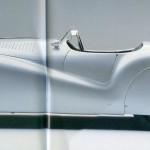
Here’s The Profile Of The BMW 328 Mille Miglia. You Can Note The Similarity Of It To The Victress S1. Keep In Mind That The Wheelbase of the BMW Was Just 94.5 Inches – Nearly Identical to the Smaller Fiberglass Cars of the 1950’s Which Typically Had A 94 Inch Wheelbase.
But wait! (I feel like the RONCO Popeil Pocket Fisherman TV Ad Man…)
As I was preparing today’s story, Erich Schultz contacted me again, and focused my review on the “prototype” or first car built by BMW in this series which was the “1939 BMW 328 Mille Miglia “Buegelfalte” Roadster. Erich took the time and pointed out even greater similarities between this very first car and the Victress S1A.
Pretty interesting stuff here gang, and I think you’ll find the similarities of the “Buegelfalte Roadster” to the Victress S1 even more striking. More about that in our final article on “Designs That Influenced the Styling of the Victress S1 and Glasspar G2” which will appear later this week.
Until then..
Glass on gang..
Geoff
——————————————————————-
Click on the Images Below to View Larger Pictures
——————————————————————-
- Here You Can See The Similarity Between The BMW and Victress Automobiles. This Prewar Design Was Created in 1939 By BMW.
- The BMW 328 Mille Miglia Is A Strikingly Beautiful Car. It’s Hard To Believe This Design Debuted In 1939!
- Only The Front Of The Victress S1 Is Significantly Different In Design From The BMW 328 Mille Miglia Roadster.
- These Comparison Images Show The Rear Of Both The BMW And Victress Automobiles. Keep In Mind That The Victress S1 is On A 100″ Wheelbase While The BMW’s Is 94.5″.
- Here’s The Profile Of The BMW 328 Mille Miglia. You Can Note The Similarity Of It To The Victress S1 In Many Ways. Keep In Mind That The Wheelbase of the BMW Was Just 94.5 Inches – Nearly Identical to the Smaller Fiberglass Cars of the 1950’s Which Had A 94 Inch Wheelbase.
- Shown Here Is The Dashboard of the BMW 328 Mille Miglia Roadster. I Think I’ll Be Using This As The “Prototype” Dashboard For Any Future Victress S1 Projects. You Also Might Notice That It’s Nearly Identical To The Factory Dashboard Of Tritt’s Glasspar G2.


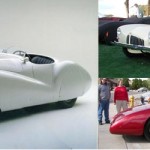
This site is protected by reCAPTCHA and the Google Privacy Policy and Terms of Service apply.